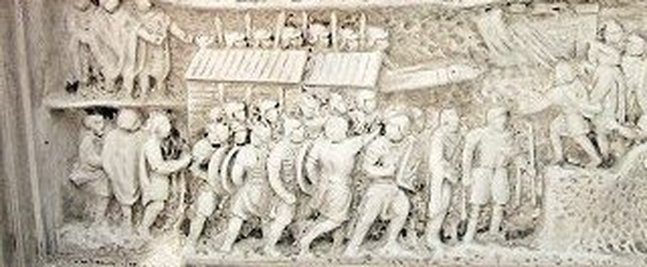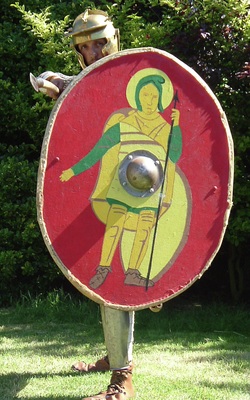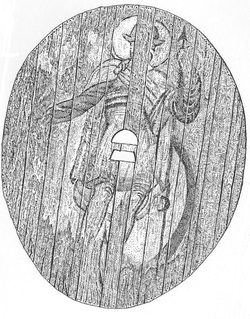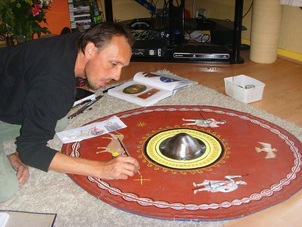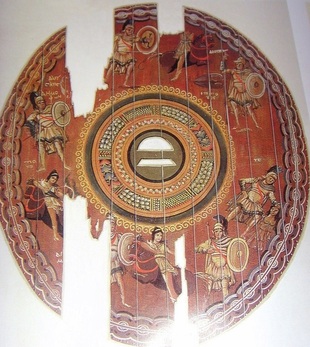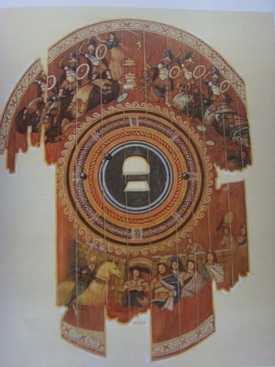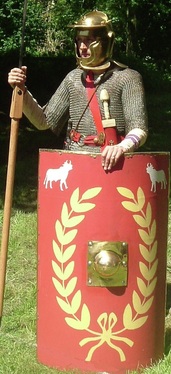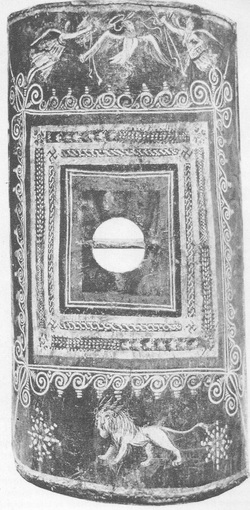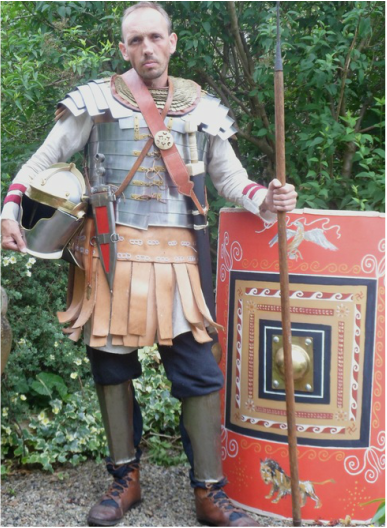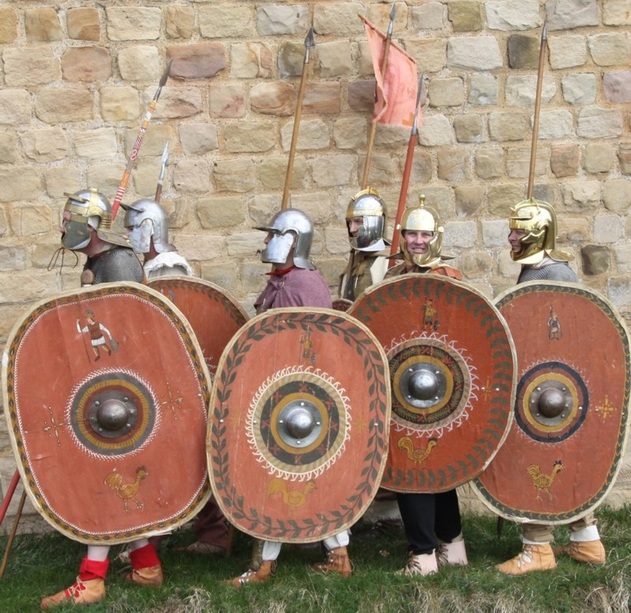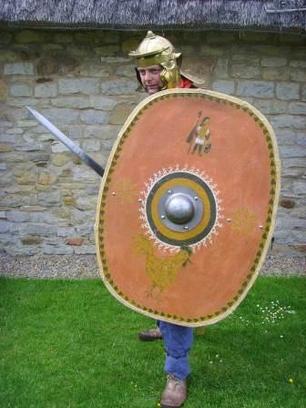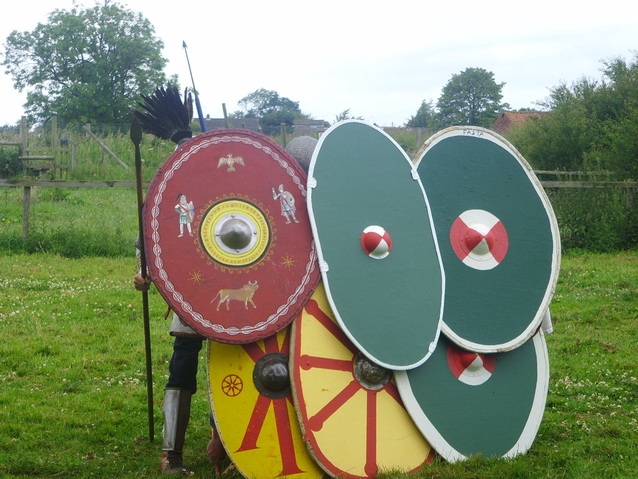SHIELD
The most common type of shield attested in wall paintings and sculpture for the 3rd century is circular or oval - and large, but the familiar rectangular shield was also still in use. Below is a section of the arch of Septimus Severus, a monument built to commemorate his victories against Parthia in 197-198AD. Note some legionaries wear lorica segmentata, others appear to wear chainmail, and most carry the new style of oval shield. One legionary (centre) carries one of the traditional curved rectangular shields.
THE OVAL SHIELD
A number of well preserved Roman shields were discovered at the site of Dura Europus in modern-day Syria (dated to the mid-3rd century), and these have provided us with fascinating details about Roman shield construction. Broad oval shields were in the majority, and they measured between 107cm and 118cm in length, and between 92 and 97cm in width. Although the use of plywood was well known to the Romans, most of the Dura shields were manufactured with planks of poplar wood, 8-12mm thick (figure 8). Two hand holes were cut in the centre, and the space between provided a handgrip, often reinforced with an iron bar. Holes for the stitching on of a rawhide or leather rim were discovered around the outside edges of the shields. In the centre of each shield would be an iron or bronze boss, a dome of metal that protected the hand of the shield-bearer.
A number of well preserved Roman shields were discovered at the site of Dura Europus in modern-day Syria (dated to the mid-3rd century), and these have provided us with fascinating details about Roman shield construction. Broad oval shields were in the majority, and they measured between 107cm and 118cm in length, and between 92 and 97cm in width. Although the use of plywood was well known to the Romans, most of the Dura shields were manufactured with planks of poplar wood, 8-12mm thick (figure 8). Two hand holes were cut in the centre, and the space between provided a handgrip, often reinforced with an iron bar. Holes for the stitching on of a rawhide or leather rim were discovered around the outside edges of the shields. In the centre of each shield would be an iron or bronze boss, a dome of metal that protected the hand of the shield-bearer.
|
Above: Wooden shield found at Dura Europus (AD 260) depicting an Eastern warrior god. This may be a unit insignia (illustration G.Sumner) Left: A reconstruction of the warrior god shield carried by Fortunatus. Note the size and the protection it provides, leaving only his face, foot and hand open to attack.
|
|
Right. Here I am painting a new oval shield with a design based on shields found at the ruined Roman city of Dura Europus (255-257AD). These shields are red in colour (the colour of Mars, god of war) and include wreaths around the boss, a border decoration and detailed figures or creatures. They differ from the shield patterns of the 2nd century. It seems that the famous Roman lightning bolts and eagle wings were no longer used in the 3rd century. |
Were all soldiers' shields this elaborate? Perhaps ... if soldiers painted their own shields then they may have spent long hours in barracks painting and re-painting them. If the shields were painted by a legionary craftsman, then junior and senior officers may have spent money to commission a finely painted shield design (incorporating heroes and stories from the Greek myths).
Below. The two red-painted oval shields from Dura. Both incorporate heroes from myth. Fortunatus' shields uses the same basic designs, but only incorporates a couple of mythical figures (Hector and Achilles).
Below. The two red-painted oval shields from Dura. Both incorporate heroes from myth. Fortunatus' shields uses the same basic designs, but only incorporates a couple of mythical figures (Hector and Achilles).
THE RECTANGULAR SHIELD
The famous curved rectangular scutum of the legions continued in use well into the 3rd century, but was used not used universally all the time (If it ever was!). The victory column of Septimus Severus shows soldiers mainly carrying oval shields, but more than one rectangular shield has been found dated to the 3rd century. Were they used by certain units? Were they used for certain types of campaigns of missions? They are great for close quarter combat but limit movement, and they excel in siege combat. Fortunatus has both types of shield for different operations.
The famous curved rectangular scutum of the legions continued in use well into the 3rd century, but was used not used universally all the time (If it ever was!). The victory column of Septimus Severus shows soldiers mainly carrying oval shields, but more than one rectangular shield has been found dated to the 3rd century. Were they used by certain units? Were they used for certain types of campaigns of missions? They are great for close quarter combat but limit movement, and they excel in siege combat. Fortunatus has both types of shield for different operations.
|
Of the four fragments of rectangular shield ever found, three of them were found at Dura Europus dated to the mid 3rd century. Right: One of the elaborately painted scuta. The lion is probably an emblem for a detachment or century. Above: Fortunatus has a rectangular scutum painted with an early design for the Sixth Legion. Note the bull, the emblem of the Sixth, and the victory wreath, denoting their nickname 'Victix - Victorious'
|
Fortunatus' rectangular scutum decorated in the manner of the Dura Europus scutum (see black and white photograph of the original, above).
|
Each shield was faced with leather or with linen, which both strengthened the shield and allowed it to be painted. Paints were not as vivid and as hard-wearing as modern acrylic paints, however. Experiments by the re-enactment group Cohors Quinta Gallorum, operating from the Roman fort at South Shields, have shown that shields can be painted using paint made with an egg base. The yolk gives a slight gloss, but is slightly soft, whilst the 'glair' gives a harder finish, but is more brittle. Glair is made from egg-white which has been whipped to froth and allowed to stand, or strained through a cloth or a sponge. It was found that a mixture of the two works well. How often a soldier was able to repaint is shield is unknown, on campaign, such touching up might prove difficult, but a legionary like Fortunatus in garrison would no doubt have the time and materials to repaint his shield. Fortunatus, like other soldiers, also painted on his name and his unit for identification purposes. He most likely painted the inside of his shield any colour he desired, and he may have copied patterns he liked. |
How to Make a Flat Roman Shield
Robert Vernmaat's highly useful instructional web-page devoted to making an oval late Roman shield.
How to Make a Curved Shield
Design notes for making the famous curved rectangular shield. Written by members of Tennessee's Legio V Alaudae
re-enactment group. |
Members of 3rd century re-enactment group Quinta, depicting Cohors Quinta Gallorum, the Fifth cohort of Gauls, based at Arbeia (modern South Shields). This fort was rebuilt by Severus for use as a supply base during his British War of 208-210.
|
Shields made the army. Without a shield, a Roman soldier is simply a walking target. Unlike the sword fights of Hollywood movies, hand-to-hand fights did not often turn into 'steel-on-steel' combats with swords clanging on sword with lunges and parries. These weapons, as experience has shown, do not take kindly to such treatment. A shield was the only real defence. As a unit the legionaries could, at an order, lock their large oval shields together, to create a defensible barrier from which they could launch spear attacks and repel an enemy charge. This tactic was particularly successful against cavalry. With the foulkon manoeuvre, the shields of an entire unit were used to create a shield wall behind which the frontline crouched; the second and third lines lifted up their shields to create a 'roof' that was proof against hostile missile fire. Finally, the unit could manoeuvre close to an enemy or a city wall under siege using a tactic called a 'testudo'. Much like a foulkon, the shields were used to box in the legionaries, but this formation gave the unit the ability to move, albeit slowly, and could advance toward a hostile city wall without suffering casualties from skirmishers. |
